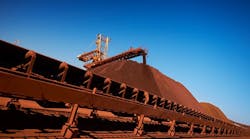The world’s top iron ore shipper is bullish about prices for the next five years even as the world’s largest steelmaker produces less steel.
Iron ore will average $45 a metric ton in 2016, Australia’s Department of Industry, Innovation & Science said in a quarterly outlook on April 8, raising its outlook from $41.30 projected in December. As high-cost miners close, Australian producers will boost shipments, and prices will gain to $56 next year, $61.40 in 2018 and rise to $64.70 in 2021, the department estimated.
The commodity has staged a surprise rebound in 2016 as China’s policy makers signaled they’re prepared to support growth in the largest user. While the advance hasn’t swayed many skeptics with banks including Goldman Sachs Group Inc. reiterating bearish forecasts, Australia projects that its giant low-cost producers, together with Brazil’s Vale SA, will claim a greater share of global trade and prices will climb.
“The increased exports is a result of continued closures in the Chinese domestic industry,” said Daniel Hynes, senior commodity strategist at Australia & New Zealand Banking Group Ltd. in Sydney. “This is a fair assessment of the market over the medium-to-longer term,” he said, citing the price outlook.
The department’s forecasts by the refer to spot ore with 62% content free-on-board Australia. The raw material delivered to Qingdao in China, which rose 23% in the first three months, was at $54.70 a dry ton on April 7 Thursday, according to Metal Bulletin Ltd. Futures in Asia fell on Friday, with the SGX AsiaClear contract down 1% to $49.09 at 3:02 p.m. in Singapore.
As China slows and policy makers shift the economy toward consumption and away from investment, steel production and demand are both shrinking in the country that accounts for about half global supply. Steel output in China will drop to 781 million tons this year from 806 million in 2015, the report forecast. By 2021, China’s output would be down to 706 million tons, it said.
Iron ore cargoes from Australia will probably increase to 846 million tons this year and 881 million tons in 2017 as billionaire Gina Rinehart’s Roy Hill venture ramps up operations, according to the department. Over the medium term, exports may be supported by an expansion of production from the country’s largest producer, Rio Tinto Group, the department said. By 2021, shipments may be 926 million tons, it said.
The Roy Hill project in Western Australia’s ore-rich Pilbara is targeting output of 55 million tons a year. It began exporting in December and last month dispatched its first China-bound cargo.
New Capacity
“New low-cost capacity is expected to be commissioned over the projection period, which is expected to further displace higher-cost producers,” the department said. “Growth in supply from Australia in the short term is largely attributable to the anticipated increase in production from Roy Hill.”
Australia and Brazil, the two biggest suppliers, will account for about 90% of global trade by 2021, up from 77% last year, it said. Even as steel demand wanes, China’s imports may exceed 1 billion tons this year and remain at about that level for the next five years, according to the report. The country will probably purchase 98% of its iron ore needs from the seaborne market by 2021, up from 83% from 2015.



